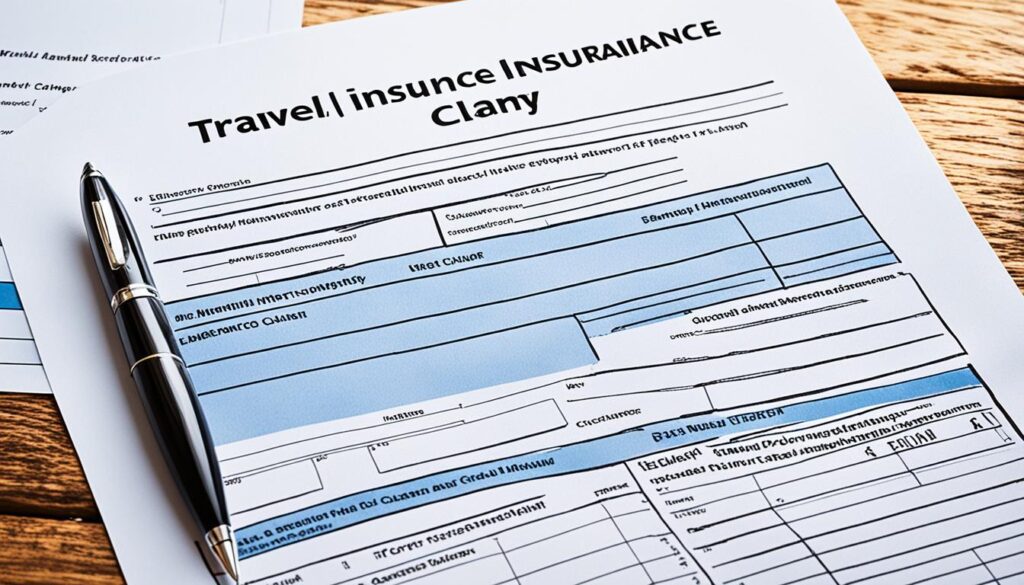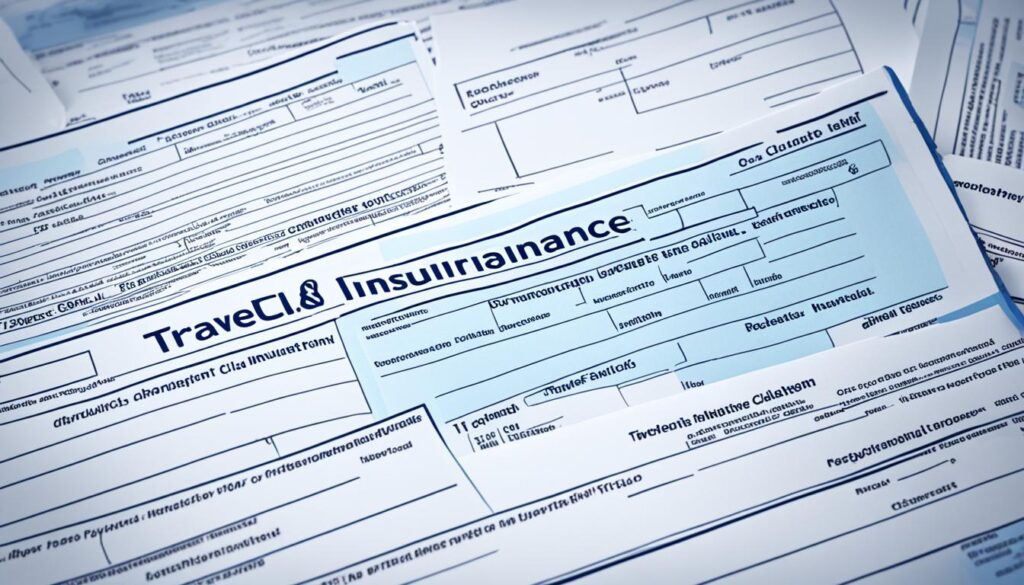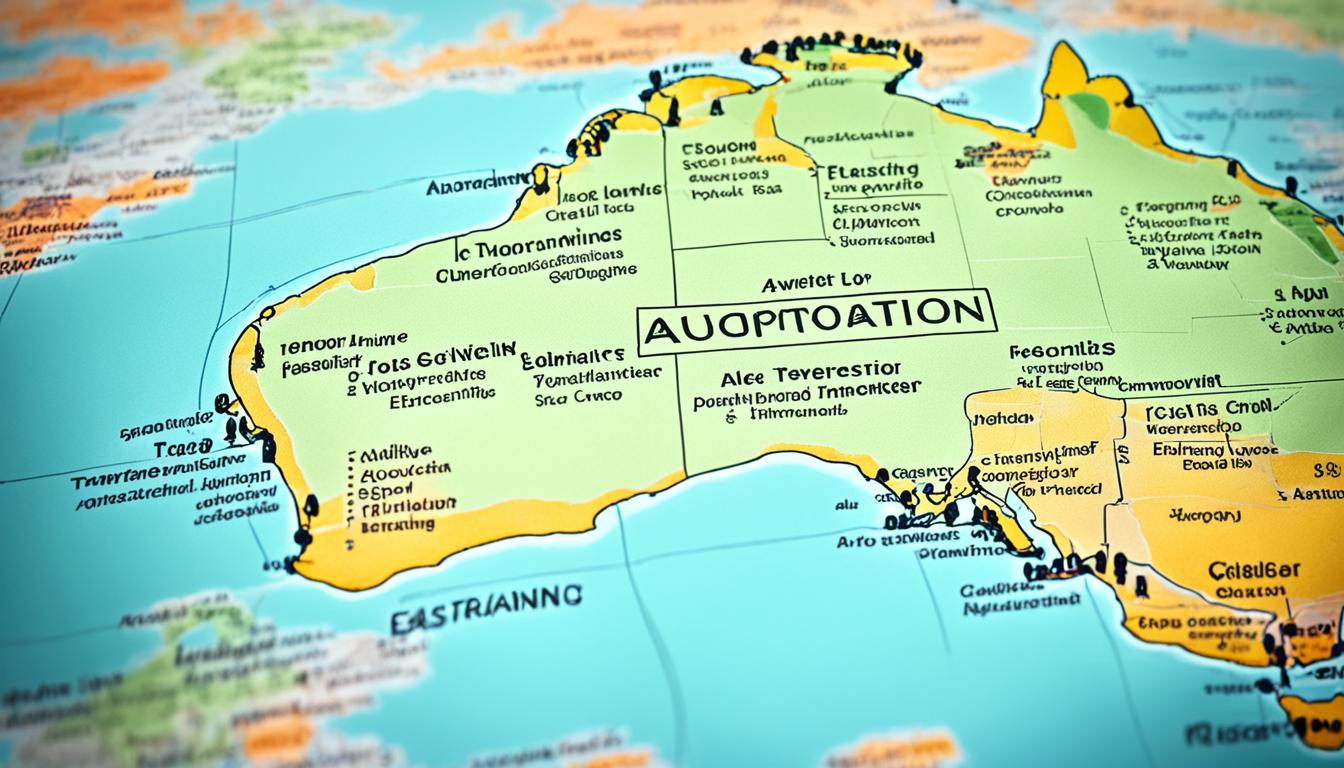
Travel insurance is a vital companion for any journey, offering you financial protection and peace of mind in the face of unforeseen circumstances. However, filing a travel insurance claim can sometimes be a complex process, leaving many travelers unsure of how to proceed.
In this comprehensive guide, we will provide you with a step-by-step overview of the travel insurance claim process. From understanding coverage and gathering documentation to submitting your claim and following up, we will walk you through each stage, ensuring a smooth and efficient reimbursement experience.
Whether you’re facing a medical emergency, lost baggage, trip cancellation, or any other covered incident, our guide will equip you with the necessary knowledge to confidently navigate the travel insurance claim process.
Key Takeaways:
- Understanding the travel insurance claim process is essential for a swift and efficient reimbursement.
- Knowing your coverage and eligibility criteria is crucial to ensure you meet the necessary requirements for making a claim.
- Collecting the required documentation in advance will expedite the claim process.
- Promptly reporting the incident or loss to your travel insurance provider is vital to initiate the claim process.
- Accurately filling out the claim form and submitting it along with the supporting documents is crucial for a successful claim.
Understanding Travel Insurance Coverage
When it comes to travel insurance, understanding the coverage provided by your policy is essential. This knowledge will not only help you make an informed decision when purchasing insurance but also ensure that you meet the eligibility criteria for making a claim. In this section, we will explore the different aspects of travel insurance coverage to guide you through the reimbursement process.
Types of Travel Insurance Coverage
Travel insurance policies can vary in their coverage, so it’s important to read the terms and conditions carefully. Here are some common types of coverage you may find:
- Medical Expenses: This coverage reimburses medical expenses resulting from an illness or injury during your trip.
- Trip Cancellation or Interruption: If your trip gets canceled or interrupted due to unforeseen circumstances such as illness, natural disasters, or job loss, this coverage can reimburse your non-refundable expenses.
- Baggage Loss or Delay: If your luggage is lost, stolen, or delayed, this coverage can provide reimbursement for essential items and expenses.
- Travel Delay: If your trip is delayed due to a covered reason, this coverage can reimburse you for additional expenses such as accommodation and meals.
These are just a few examples of the coverage options available in travel insurance policies. Each policy may have additional coverage types or variations, so be sure to review the details before purchasing.
Eligibility for Making a Travel Insurance Claim
In order to be eligible for reimbursement, it’s important to meet the criteria set by your travel insurance policy. While specific requirements may vary, the following factors generally determine claim eligibility:
- Policy Activation: Your policy must be active and in effect at the time of the covered incident or loss.
- Valid Reason for Claim: The incident or loss must be covered under your policy. Common reasons for claims include medical emergencies, trip cancellations, or baggage loss.
- Timeliness: You must report the incident or loss to your travel insurance provider within the specified time frame mentioned in your policy.
- Documentation: You are required to provide the necessary documentation to support your claim, such as medical records, police reports, or receipts.
Meeting these eligibility criteria is crucial to ensure a successful travel insurance claim. In the next section, we will discuss the necessary documentation you need to gather to support your claim.
Gathering Required Documentation
When filing a travel insurance claim, it is essential to gather all the necessary documentation to support your case and ensure a smooth and efficient claim process. By having the right paperwork ready, you can expedite the evaluation of your claim and increase the likelihood of a successful reimbursement. Here are the key documents you need to collect:
1. Proof of travel
To validate your claim, you will need to provide evidence of your travel plans, such as flight itineraries, hotel reservations, or tour bookings. These documents serve as proof that your trip was scheduled and can support your claim for canceled or interrupted travel.
2. Medical reports and receipts
If your claim is related to medical expenses incurred during your trip, make sure to gather medical reports, bills, and receipts from healthcare providers. These documents will help verify the medical treatment received and the associated costs.
3. Police reports
If you experienced theft, loss, or vandalism during your trip, it is crucial to file a police report at your travel destination. Ensure you obtain a copy of the report, as it serves as evidence of the incident and strengthens your claim for reimbursement.
4. Proof of ownership or value
If you need to claim for lost, stolen, or damaged items, it is vital to provide evidence of ownership or the value of the items. Receipts, warranty certificates, or photographs can support your claim and expedite the evaluation process.
5. Travel insurance policy details
Have a copy of your travel insurance policy readily available, including the policy number, coverage details, and contact information for your insurance provider. This information will help facilitate communication throughout the claims process.
Remember: Documentation is key to a successful travel insurance claim. It is crucial to keep all original documents and make copies for submission. Providing comprehensive and accurate documentation can significantly increase your chances of a successful claim.
Having all the required documentation ready will not only expedite the claims process but also ensure that you submit a complete and compelling case for reimbursement. Keep in mind that specific additional documents may be necessary depending on the nature of your claim and the travel insurance policy you have. Refer to your policy documents or contact your insurance provider for any specific requirements.
Reporting the Incident or Loss
Once you experience an incident or loss that is covered by your travel insurance policy, it’s crucial to report it promptly. Reporting the incident as soon as possible will help expedite the process of filing your travel insurance claim and ensure that you receive the necessary assistance and reimbursement in a timely manner.
When reporting the incident or loss, follow these step-by-step guidelines:
- Notify the authorities: In case of theft, accident, or any criminal activity, report the incident to the local authorities or police as soon as possible. Obtain a copy of the police report or incident report, as it will be required when you file your travel insurance claim.
- Contact your travel insurance provider: Reach out to your travel insurance company’s claims department or customer service helpline to inform them about the incident or loss. Provide them with all the necessary details, such as the date, time, and location of the incident, as well as any relevant documentation you may have, including police reports, medical records, or photographs.
- Follow their instructions: Your travel insurance provider will guide you through the next steps and inform you about any additional documentation or information they may require. It’s important to follow their instructions carefully to ensure a smooth and efficient claim process.
Remember, reporting the incident or loss promptly is crucial in order to initiate the travel insurance claim process. Failure to report within the specified timeframe may result in your claim being denied or delayed.
Pro Tip: Keep a record of all communication and correspondence with your travel insurance provider, including dates, times, names of the representatives you spoke to, and any reference or claim numbers provided. This will help you track the progress of your claim and provide evidence of your proactive approach.
By promptly reporting the incident or loss covered by your travel insurance policy, you can ensure a smooth and efficient travel insurance claim process. Following these steps will help expedite your claim and increase your chances of receiving the reimbursement you are entitled to.
Contacting Your Travel Insurance Provider
Once you have gathered all the necessary documentation and reported the incident or loss covered by your travel insurance policy, it’s time to initiate the claim process by contacting your travel insurance provider. Timely communication with your provider is crucial to ensure a smooth and efficient travel insurance claim process.
When reaching out to your travel insurance provider, make sure you have the following information readily available:
- Your policy number
- Date and details of the incident or loss
- Any relevant supporting documentation
It’s important to note that different insurance providers may have varying methods of contact. Here are some common ways to get in touch with your travel insurance provider:
- Phone: Check your policy documents for the dedicated claims helpline number. Be prepared to provide all the necessary details over the phone.
- Email: Some insurance providers offer the option to initiate a claim via email. Make sure to include all the required information in your email.
- Online portal: Many insurance companies have an online portal where you can log in and submit your claim. This option allows for easy access to your policy details and simplifies the claims process.
Remember to keep a record of your communication with the insurance provider, including date, time, and the name of the representative you spoke to. This documentation can be valuable in case of any discrepancies or disputes down the line.
Once you have successfully contacted your travel insurance provider, they will guide you further on the next steps of the claim process. Stay proactive and follow their instructions to ensure a swift resolution.
Having a clear understanding of how and when to contact your travel insurance provider will make the overall travel insurance claim process smoother and more efficient. Take the necessary steps to initiate your claim promptly, and keep all relevant information at hand for seamless communication with your provider.
Filling out the Claim Form
Once you have reported the incident or loss covered by your travel insurance policy, the next step is to fill out the claim form accurately. Providing all the necessary details will help prevent any delays in the reimbursement process.
When completing the claim form, make sure to:
- Fill in your personal information, including your full name, contact details, and policy number. Double-check the accuracy of these details to avoid any communication issues.
- Provide a detailed description of the incident or loss. Include all relevant information, such as the date, time, and location. Be specific and concise, focusing on the essential facts.
- Attach supporting documentation to validate your claim. This may include receipts, invoices, police reports, medical records, or any other evidence that substantiates your claim.
- Review the form before submitting it to ensure that all fields are complete and accurate. Any missing or incorrect information can lead to processing delays.
Keep in mind that different insurance providers may have slightly different claim forms. Make sure to follow the instructions provided by your specific travel insurance company and comply with any additional requirements they may have.
Pro Tip: Take your time filling out the claim form and ensure that all the information you provide is accurate and supported by the necessary documents. Making sure everything is complete and accurate from the start will help expedite the claim process.
Refer to the example table below for a better understanding of the information typically required in a travel insurance claim form:
| Information Required | Description |
|---|---|
| Policyholder’s Name | Your full legal name as it appears on your policy |
| Contact Information | Your current address, phone number, and email address |
| Policy Number | The unique identifier for your travel insurance policy |
| Date and Time of Incident | The exact date and time when the incident occurred |
| Incident Description | A detailed account of what happened, including all relevant facts |
| Supporting Documents | Receipts, invoices, reports, or any other evidence related to your claim |
Example Claim Form

Once you have completed the claim form and attached all the necessary documentation, it’s time to submit it to your travel insurance provider. The next section will guide you through the submission process and provide additional tips for a seamless travel insurance claim experience.
Submitting the Claim Form and Supporting Documents
Once you have completed the necessary claim form and gathered all the required documents, it’s time to submit them to your travel insurance provider. This step is crucial in ensuring a successful claim and a smooth reimbursement process.
To submit your claim form and supporting documents, follow these steps:
- Compile your documents: Make sure you have all the necessary supporting documents ready, such as medical reports, police reports, receipts, and any other evidence related to your claim. Organize them in a logical order for easy reference.
- Review your claim form: Double-check your completed claim form for accuracy and completeness. Ensure that all relevant sections are filled out correctly, providing detailed information about the incident or loss.
- Create copies: Before submitting your original documents, make copies of everything for your records. This precautionary measure will protect you in case any of the documents get lost during the submission process.
- Prepare your submission package: Place the original claim form and all supporting documents together in a secure and well-sealed envelope or folder. Clearly label it with your name, policy number, and claim reference number (if provided).
- Select a submission method: Choose the submission method that your travel insurance provider offers. This can include options such as online upload, email, fax, or traditional mail. Check with your provider to determine the most convenient and efficient method for submission.
- Submit your claim: Submit your claim package via the chosen method. Follow any specific instructions provided by your travel insurance provider, ensuring that you meet all submission deadlines.
Remember: Keep a record of the date and time of your submission, as well as any confirmation or reference numbers provided by your travel insurance provider. This documentation will be helpful in case you need to follow up on your claim or address any issues that may arise.
By carefully preparing and submitting your claim form and supporting documents, you increase the chances of a prompt and successful reimbursement. Remember, each travel insurance provider may have specific requirements and submission processes, so it’s crucial to follow their instructions closely.
Example Submission Package Checklist:
| Document | Original | Copy |
|---|---|---|
| Completed claim form | ✓ | ✓ |
| Medical reports | ✓ | ✓ |
| Police reports | ✓ | ✓ |
| Receipts | ✓ | ✓ |
| Evidence of loss or damage | ✓ | ✓ |
| Other supporting documents | ✓ | ✓ |
By submitting a complete and well-organized claim package, you provide your travel insurance provider with all the necessary information and evidence to review and process your claim. This proactive approach will help expedite the reimbursement process, ensuring a smooth experience for you.
Next, we’ll discuss how to follow up on your claim and stay informed about its progress.
Following Up on Your Claim
Once you’ve submitted your travel insurance claim, it’s important to stay proactive and follow up on its progress. By doing so, you can ensure a smooth and efficient reimbursement process. Here are a few steps to help you stay informed:
1. Keep track of your claim reference number
After submitting your claim form and supporting documents, your travel insurance provider will assign you a unique claim reference number. This number serves as your identifier throughout the claim process. Make sure to keep it handy for reference purposes when contacting your provider.
2. Contact your travel insurance provider
If you haven’t received any updates on your claim within the expected timeframe, reach out to your travel insurance provider. Use the contact information provided by them during the initial claim submission or visit their website for specific instructions. When contacting them, be prepared to provide your claim reference number and any other relevant details.
3. Request updates on the status of your claim
During your communication with your travel insurance provider, ask about the current status of your claim. They should be able to provide you with information on whether your claim is under review, if any additional documentation is required, or if a settlement has been reached.
4. Document your conversations
Take notes of any conversations you have with your travel insurance provider. Make sure to record the date, time, and the name of the person you spoke to. This documentation can be helpful in case you need to reference any previous discussions or escalate the matter further.
| Beneficial Tip | Reason |
|---|---|
| Stay organized | Keeping all your documentation, including the claim form, supporting documents, and any correspondence, in one place will facilitate easy access when following up on your claim. |
| Be patient, yet persistent | Reimbursement processes can take time, so it’s important to be patient. However, if you haven’t heard back within a reasonable timeframe, don’t hesitate to reach out to your insurance provider for updates. |
| Remain courteous | While it can be frustrating if your claim progress is delayed, maintaining a polite and respectful tone during your interactions will help foster a more positive resolution. |
By following up on your travel insurance claim, you can ensure that it receives the attention it deserves. Remember to document your conversations and be persistent in seeking updates on the status of your claim. Your proactive approach will help expedite the reimbursement process.
Reviewing Your Claim and Settlement
Once you have submitted your travel insurance claim, it is important to understand how the insurance provider reviews your claim and determines the settlement amount. This process can vary slightly depending on the insurance company, but generally follows a standard procedure.
First, the insurance provider will review the documentation you submitted along with your claim form. This includes any supporting documents such as medical reports, police reports, or receipts for lost items. They will carefully assess the validity of your claim based on the information provided.
Next, the insurance company will evaluate the coverage provided by your policy and compare it to the details of your claim. They will ensure that the incident or loss falls within the scope of coverage outlined in your policy. If there are any discrepancies or uncertainties, they may contact you for further clarification.
Once the review process is complete, the insurance provider will determine the settlement amount. This amount is based on various factors, including the extent of the loss or damage, the coverage limits of your policy, and any deductibles that apply. The settlement amount will be the maximum amount the insurance company is liable to pay for your claim.
It is important to note that the settlement amount may be different from the total value of your claim, especially if there are deductibles or limits on certain types of losses. You should carefully review your policy to understand these limitations.
After the settlement amount has been determined, the insurance company will communicate their decision to you. They will provide you with a detailed explanation of the settlement and any further steps required to complete the claim process. It is important to carefully review this information and contact the insurance company if you have any questions or concerns.
Remember, the review and settlement process can take some time, especially if there are complex details or if additional information is required. It is important to be patient and follow up with the insurance provider if necessary.
| Steps in the Claim Review and Settlement Process |
|---|
| 1. Review of submitted documents and claim form |
| 2. Evaluation of policy coverage and claim details |
| 3. Determination of settlement amount |
| 4. Communication of settlement decision to the policyholder |
Appeals and Disputes Resolution
Dealing with a denied travel insurance claim can be frustrating, but it’s important to know that you have options for resolution. Here are some steps you can take to appeal or resolve disputes if your claim is initially denied:
- Review your policy: Carefully read your travel insurance policy to understand the specific terms, conditions, and exclusions that may affect your claim.
- Contact your insurer: Reach out to your travel insurance provider to express your concerns and seek clarification on the denial. Ask for a detailed explanation of the reasons behind the decision.
- Provide additional information: If you believe there was a misunderstanding or missing information, gather any additional evidence or documentation that supports your claim. Submit this information to your insurer for reconsideration.
- Work with a claims specialist: Consider engaging the services of a professional claims specialist or public adjuster who can advocate for you and help navigate the appeal process.
- Follow internal appeals process: If your insurer has an internal appeals process, make sure to follow the steps outlined. This may involve submitting a formal written appeal and providing any requested documentation.
- Seek external assistance: If your internal appeal is still unsuccessful, you can explore external avenues for resolution. This may include filing a complaint with your state’s insurance regulatory agency or seeking assistance from a consumer advocacy organization.
Remember to keep thorough records of all communications with your insurer, including dates, times, and the names of the individuals you spoke with. This documentation will be valuable should you need to escalate your claim or involve external parties.
“When appealing a denied travel insurance claim, persistence and organization are key. Keep a detailed record of all interactions with your insurer and provide any additional evidence that supports your case.”
External Avenues for Resolution
| Avenue | Description |
|---|---|
| State Insurance Regulatory Agency | Contact your state’s insurance regulatory agency to file a complaint and seek guidance on how to proceed with your denied claim. |
| Consumer Advocacy Organizations | Reach out to consumer advocacy organizations that specialize in insurance matters. They may provide advice and advocacy services for resolving claim disputes. |
Tips for a Smooth Claim Process
When it comes to filing a travel insurance claim, being prepared and knowledgeable can make all the difference. To ensure a smooth and successful claim process, keep these tips in mind:
1. Familiarize Yourself with the Policy Coverage
Before you embark on your trip, take the time to thoroughly read and understand your travel insurance policy. Familiarize yourself with the coverage details, including what is and isn’t covered, as well as any limitations or exclusions. This will help you make informed decisions and avoid potential claim denials.
2. Maintain Clear and Detailed Records
Throughout your trip, keep detailed records of any incidents, losses, or expenses that may require a claim. This includes taking pictures, collecting receipts, and obtaining official reports or documentation whenever possible. Clear and comprehensive records will strengthen your claim and make the process more efficient.
3. Report Incidents Promptly
If you encounter an incident or loss during your trip that is covered by your travel insurance policy, it is essential to report it to the relevant authorities and your insurance provider as soon as possible. Prompt reporting helps establish the timeline and validity of your claim, preventing any delays or complications.
4. Follow the Claim Process Step-by-Step
Each insurance provider may have their own specific claim process, so it is crucial to familiarize yourself with the steps and requirements outlined by your provider. Follow the process diligently, ensuring that you submit the necessary documents, forms, and information accurately and within the specified timeframe.
5. Double-Check Your Claim Form
Before submitting your claim form, review it thoroughly to ensure that all the information provided is accurate and complete. Any missing or incorrect details can lead to delays or potential claim rejections. Take the time to double-check your form and make any necessary corrections before submission.
6. Avoid Common Mistakes
When filing a travel insurance claim, it is crucial to avoid common mistakes that can jeopardize your chances of a successful claim. Some of these mistakes include submitting incomplete documentation, overlooking specific policy requirements, or failing to report incidents within the specified timeframe. By being aware of these common pitfalls, you can increase your chances of a seamless claim process.
By following these tips, you can navigate the travel insurance claim process with confidence, increasing your chances of a successful reimbursement. Remember, being proactive, organized, and attentive to details can save you time and frustration in the long run.

Understanding Reimbursement Timeframes
When it comes to travel insurance claims, it’s essential to have a clear understanding of the typical reimbursement timeframes. This knowledge will help you manage your expectations and have a smoother experience throughout the process.
Every travel insurance provider has its own specific claim processing timeline. However, there are general patterns that can give you an idea of what to expect. Keep in mind that these timeframes can vary depending on the complexity of your claim and the volume of claims handled by the insurance company.
Here is an overview of the typical reimbursement timeframes for travel insurance claims:
- Claim Submission: Once you submit your claim form and supporting documents, the insurance company will begin the review process. This usually takes a few business days.
- Initial Review: During this stage, the insurance company will assess the completeness and validity of your claim. They may request additional information or documentation if needed. The initial review process typically takes a week or two.
- Evaluation and Verification: Once your claim passes the initial review, it will undergo a thorough evaluation and verification process. This includes assessing the coverage limits, policy terms, and supporting documents. Depending on the complexity of the claim, this stage can take anywhere from a few weeks to a couple of months.
- Settlement Offer: After the evaluation process, the insurance company will make a settlement offer based on their findings. This offer may be subject to negotiation, especially if you believe the initial offer does not adequately cover your losses. The negotiation process can add a few extra weeks to the overall timeframe.
- Final Approval and Payment: Once you and the insurance company reach an agreement on the settlement amount, the final approval and payment process will be initiated. This typically takes a few business days to complete, and the payment will be disbursed according to the method specified by the insurance company.
Managing Expectations
Keep in mind that the entire travel insurance claim process can take several weeks to a few months from start to finish. Factors such as claim complexity and the responsiveness of the insurance company can influence these timeframes.
It’s important to stay patient and follow up with your insurance provider regularly to expedite the process. If you have any concerns or questions about the status of your claim, don’t hesitate to reach out to your insurance company’s customer service department for updates.
Understanding the reimbursement timeframes will help you plan your finances and manage your expectations during the travel insurance claim process. Remember, every case is unique, and some claims may take longer than others, but staying informed and proactive will ensure a smoother experience overall.
Additional Coverages and Claim Considerations
When it comes to travel insurance, understanding the additional coverages and claim considerations specific to your policy is vital. By familiarizing yourself with these factors, you can navigate the claim process with confidence and ensure that you maximize the benefits of your travel insurance policy.
Additional Coverages
Many travel insurance policies offer enhanced coverage options that go beyond the standard benefits. These additional coverages can provide added protection and peace of mind during your travels. Some common additional coverages include:
- Emergency medical coverage
- Lost or delayed baggage coverage
- Trip delay or interruption coverage
- Cancel for any reason coverage
- Rental car coverage
Before filing a claim, review your policy to determine if any of these additional coverages apply to your situation. Understanding the specific details and requirements for these coverages will help you make informed decisions regarding your claim.
Claim Considerations
When filing a travel insurance claim, there are a few important considerations to keep in mind:
- Policy Exclusions: Familiarize yourself with any exclusions stated in your policy. Some claims may be denied if they fall under these exclusions.
- Timing: Be aware of any time limitations for filing a claim. Most policies have a specific timeframe within which the claim must be submitted.
- Documentation: Ensure that you have all the necessary documentation to support your claim. This may include receipts, medical reports, police reports, and any other relevant paperwork.
By understanding these claim considerations, you can avoid potential pitfalls and increase the likelihood of a successful claim.
“Understanding the additional coverages and claim considerations specific to your travel insurance policy is crucial for a smooth claim process and maximizing your benefits.”
| Additional Coverages | Claim Considerations |
|---|---|
| Emergency medical coverage | Familiarize yourself with policy exclusions |
| Lost or delayed baggage coverage | Be mindful of timing limitations for filing a claim |
| Trip delay or interruption coverage | Gather all necessary documentation to support your claim |
| Cancel for any reason coverage | |
| Rental car coverage |
Common Questions About Travel Insurance Claims
As you navigate the travel insurance claim process, you may have some common questions that arise. Here, we provide helpful answers and insights to address any concerns or uncertainties you may have.
1. What types of incidents are typically covered by travel insurance?
Travel insurance can cover a wide range of incidents, including trip cancellations or interruptions due to unforeseen events like illness, injury, or natural disasters. It may also provide coverage for lost luggage, medical emergencies, and emergency evacuations. It’s essential to review your policy to understand the specific incidents covered.
2. How soon should I file a travel insurance claim?
It’s crucial to report your incident or loss to your travel insurance provider as soon as possible. Many policies require you to notify them within a specified time frame, typically within a few days of the incident. Filing your claim promptly helps expedite the process and ensures your eligibility for reimbursement.
3. What documents do I need to provide when filing a travel insurance claim?
The documentation required may vary depending on the nature of your claim and your insurance provider’s specific requirements. However, common documents often requested include incident reports, medical records, receipts, proof of travel, and any other supporting evidence related to your claim. Gathering these documents ahead of time can help streamline the claim process.
4. How long does it take to receive reimbursement for a travel insurance claim?
The length of time it takes to receive reimbursement can vary depending on various factors, including the complexity of your claim and the responsiveness of your insurance provider. In general, it is advisable to allow for a minimum of several weeks, but the process may take longer in some cases.
5. What if my travel insurance claim is denied?
If your travel insurance claim is denied, you have the option to appeal the decision. Review your policy carefully to understand the appeal process and provide any additional information or supporting documents that may strengthen your case. Working closely with your insurance provider during the appeal process can help resolve any disputes and increase your chances of a successful claim.
Remember that each travel insurance policy and claim is unique, so it’s essential to thoroughly read your policy documents and consult with your insurance provider for specific answers to your questions.
6. Can I purchase travel insurance after an incident has occurred?
Generally, travel insurance needs to be purchased before an incident occurs. Retroactively seeking coverage for an incident that has already happened will not be possible and may lead to claim denial.
7. Will my travel insurance cover pre-existing medical conditions?
Travel insurance coverage for pre-existing medical conditions varies among policies and providers. Some policies may offer coverage for pre-existing conditions while others may exclude them. It’s crucial to review the terms and conditions of your policy or consult with your insurance provider to understand the coverage for pre-existing conditions.
Travel Insurance Claim Best Practices
When it comes to claiming travel insurance, following best practices can make a significant difference in your overall experience. By implementing these suggestions, you can increase your chances of a successful and smooth reimbursement process.
Gather and Organize Your Documentation
One of the key steps in the travel insurance claim process is providing the necessary documentation to support your claim. To streamline this process, gather all relevant documents such as receipts, medical reports, police reports, and any other proof of loss or expenses. Organize these documents in a logical order, making it easy to present a comprehensive claim to your insurance provider.
Understand Your Policy Coverage
Before making a travel insurance claim, take the time to thoroughly understand your policy coverage. Familiarize yourself with the terms, conditions, and exclusions to ensure that your claim falls within the policy’s scope. Being aware of your coverage will help you present a strong case and avoid any potential claim denials.
Report Incidents Promptly
When an incident or loss occurs, it’s crucial to report it to the relevant authorities and your travel insurance provider promptly. Delaying the reporting process may lead to complications and could even result in a denied claim. Be sure to follow the specific reporting procedures outlined in your policy to initiate the claim process without any unnecessary delays.
Provide Accurate Information
When filling out the travel insurance claim form, ensure that all information provided is accurate and complete. Double-check details such as dates, locations, and descriptions of the incident or loss. Providing accurate information will help streamline the review process and prevent potential issues that may arise from discrepancies.
Keep Copies of All Correspondence
Throughout the travel insurance claim process, it’s crucial to keep copies of all correspondence with your insurance provider. This includes emails, letters, claim forms, and any other communication related to your claim. These records serve as evidence of your interactions and can be invaluable in resolving any disputes that may arise.
Remember, the travel insurance claim process can sometimes be complex and time-consuming. By following these best practices, you can navigate the process more effectively and increase the likelihood of a successful claim. Stay proactive, stay organized, and provide accurate and complete information to ensure a smooth reimbursement experience.
Conclusion
In conclusion, claiming your travel insurance doesn’t have to be a complex and overwhelming process. By following the step-by-step guide provided in this article, you can ensure a smooth and efficient reimbursement. Remember to understand the coverage provided by your travel insurance policy and gather all the necessary documentation to support your claim.
Reporting the incident or loss promptly and contacting your travel insurance provider will kickstart the claim process. Fill out the claim form accurately and submit it along with the required supporting documents. Proactively follow up on your claim to stay informed about its progress.
Be aware that the travel insurance provider will review your claim and determine the settlement amount based on the policy terms and conditions. In case of any appeals or disputes, know your options and take the necessary steps to resolve the issue. Following these best practices will increase your chances of a successful claim and a hassle-free experience.





